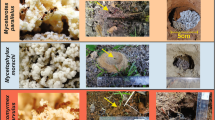Abstract
Three cases of Hebeloma radicosum growth on the wood-mouse latrine near a wood-mouse nest are here described from Switzerland. This study establishes that this fungus may associate with wood mice, besides associating with moles as has been previously known. The nest occupant and the latrine maker were independently identified to ensure that the two were not different. For this identification, the characteristics of fallen hairs found from the nest and of those found from the deserted latrines now colonized by the fungus were taken as the most important information. In addition to these case studies, information about the occurrence of H. radicosum in northern Europe and northern Japan (Hokkaido) where moles do not occur is presented, which explicitly indicates the possibility of customer animals other than moles.
Similar content being viewed by others
References
H Abe (1967) ArticleTitleClassification and biology of Japanese Insectivora (Mammalia). I J Fac Agric Hokkaido Univ 55 191–265
P Bang P Dahlstrøm (2001) Animal tracks and signs Oxford University Press Oxford
MG Day (1966) ArticleTitleIdentification of hair and feather remains in the gut and faeces of stoats and weasels J Zool 148 201–217
L Hansson (1985) ArticleTitleThe food of bank voles, wood mice and yellow-necked mice Symp Zool Soc Lond 55 141–168
S Imai (1938) ArticleTitleStudies on the Agaricaceae of Hokkaido. II J Fac Agric Hokkaido Imp Univ 43 179–378
A Kaneko N Sagara (2002) ArticleTitleResponses of Hebeloma radicosum fruit-bodies to light and gravity: negatively gravitropic and nonphototropic growth Mycoscience 43 7–13 Occurrence Handle10.1007/s102670200002
AJ Mitchell-Jones G Amori W Bogdanowicz Krysštufek PJH Reijnders F Spitzenberger M Stubbe JBM Thissen V Vohralík J Zima (1999) The atlas of European mammals T & AD Poyser London
WI Montgomery J Gurnell (1985) ArticleTitleThe behaviour of Apodemus Symp Zool Soc Lond 55 89–115
A Ohta (1998) ArticleTitleFruit-body production of two ectomycorrhizal fungi in the genus Hebeloma in pure culture Mycoscience 39 1–10 Occurrence Handle10.1007/BF02461573
N Sagara (1978) ArticleTitleThe occurrence of fungi in association with wood mouse nests Trans Mycol Soc Jpn 19 201–214
N Sagara (1980) ArticleTitleNot mouse but mole Trans Mycol Soc Jpn 21 519
N Sagara (1989) ArticleTitleEuropean record of the presence of a mole's nest indicated by a particular fungus Mammalia 53 301–305 Occurrence Handle10.1515/mamm.1989.53.2.301
N Sagara (1995a) ArticleTitleAssociation of ectomycorrhizal fungi with decomposed animal wastes in forest habitats: a cleaning symbiosis? Can J Bot 73 IssueIDsuppl 1 S1423–S1433
N Sagara (1995b) ArticleTitleA request: pinpoint marking of Hebeloma radicosum fruiting sites Mycologist 9 128 Occurrence Handle10.1016/S0269-915X(09)80279-6
N Sagara (1998) ArticleTitleMethods for studying the nesting ecology of moles through observation of mushroom fruiting (in Japanese with English summary) Honyurui Kagaku (Mammalian Science) 38 271–292
N Sagara (1999) Mycological approach to the natural history of talpid moles: a review with new data and proposal of “habitat-cleaning symbiosis.” Y Yokohata S Nakamura (Eds) Recent advances in the biology of Japanese Insectivora Hiba Society of Natural History Shobara, Hiroshima 33–55
N Sagara S Honda E Kuroyanagi S Takayama (1981) ArticleTitleThe occurrence of Hebeloma spoliatum and Hebeloma radicosum on the dung-deposited burrows of Urotrichus talpoides (shrew mole) Trans Mycol Soc Jpn 22 441–455
N Sagara Y Murakami H Clémençon (1988) ArticleTitleAssociation of Hebeloma radicosum with a nest of the wood mouse Apodemus Mycol Helvet 3 27–35
N Sagara H Okabe J Kikuchi (1993) ArticleTitleOccurrence of an agaric fungus Hebeloma on the underground nest of wood mouse Trans Mycol Soc Jpn 34 315–322
N Sagara T Hongo Y Murakami T Hashimoto H Nagamasu T Fukiharu Y Asakawa (2000) ArticleTitle Hebeloma radicosoides sp. nov., an agaric belonging to the chemoecological group ammonia fungi Mycol Res 104 1017–1024 Occurrence Handle10.1017/S0953756299002439
M Svrček (1983) Mushrooms and Fungi Octopus Books London
BJ Teerink (1991) Hair of West-European mammals Cambridge University Press Cambridge
Author information
Authors and Affiliations
Corresponding author
About this article
Cite this article
Sagara, N., Senn-Irlet, B. & Marstad, P. Establishment of the case of Hebeloma radicosum growth on the latrine of the wood mouse. Mycoscience 47, 263–268 (2006). https://doi.org/10.1007/s10267-006-0303-y
Received:
Accepted:
Issue Date:
DOI: https://doi.org/10.1007/s10267-006-0303-y




